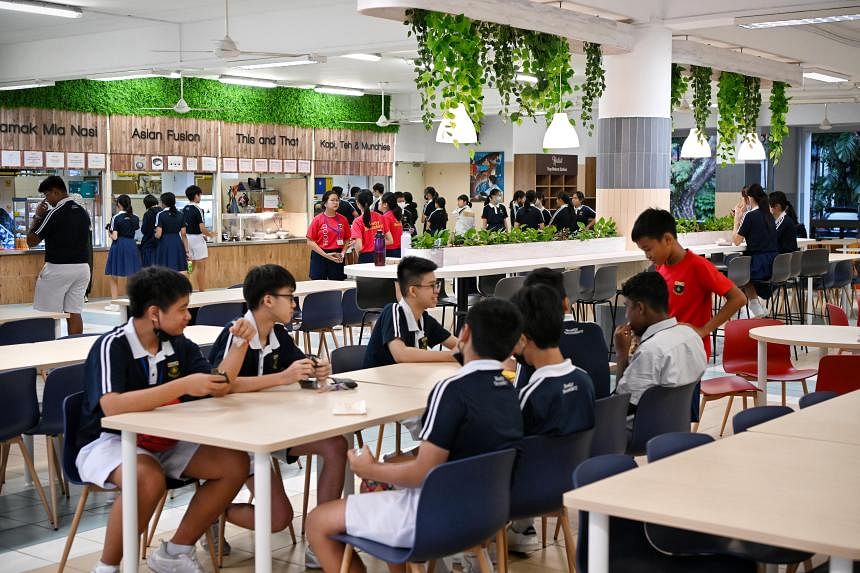
Some 6,600 15-year-old students across all secondary schools and private schools in Singapore participated in the study in 2022.
PHOTO: ST FILE
Sandra Davie
Senior Education Correspondent
Sandra Davie
Senior Education Correspondent
ST
UPDATED
JUN 18, 2024
SINGAPORE – Singapore’s 15-year-olds came out tops in a global test for creative thinking with a score of 41 points, beating students from 63 other education systems.
The Organisation for Economic Cooperation and Development (OECD) conducted the test as part of the Programme for International Student Assessment (Pisa) 2022.
It found that six in 10 of the Singapore students tested attained the two highest proficiency levels (five or six), demonstrating the ability to generate original and diverse ideas for a wide range of problem-solving tasks and contexts which required expression and imagination.
This was more than twice the OECD average proportion and the highest proportion among all 64 participating systems.
Some 6,600 15-year-old students across all 149 secondary schools and 15 private schools here, including international schools and madrasahs, participated in the study conducted from April to May in 2022.
Students from South Korea, Canada, Australia, New Zealand, Estonia and Finland took the next few top positions, scoring significantly above the OECD average of 33 points.
The test was part of Pisa 2022, which released its first report in December 2023 when it placed Singapore’s 15-year-olds as No. 1 in mathematics, science and reading.
OECD said it aimed to obtain insights into the students’ abilities through the test and questionnaire to generate, evaluate, and improve ideas, as well as their attitudes and perceptions of the school and social environments related to creative thinking.
In the one-hour test, students were given tasks that required them to generate creative ideas, as well as evaluate and improve on ideas. Full credit was awarded for uncommon ideas, while partial or no credit is awarded for common and conventional ideas.
In some scenarios in the test, students were asked to come up with ideas to improve the accessibility for wheelchair users in a library with a spiral staircase, improve an experiment for finding the cause of a problem with a frog population in a river, and suggest story ideas for a film about an intelligent robot and a human character.
OECD in its report said creative thinking measures a unique or different ability from the core domains it tests of reading, mathematics and science, because it focuses on generating new and original ideas, rather than the application of knowledge. In the creative thinking test, students tackle open problems, rather than producing the right or most optimal solution.
It said: “While creative thinking performance and academic performance complement each other, Pisa data show that it is possible for many students to be strong creative thinkers… academic excellence is not a prerequisite for excellence in creative thinking.”
The Ministry of Education (MOE) in its press release highlighted the fact that Singapore students from lower socio-economic status (SES) homes also did very well compared to their international peers.
They not only demonstrated higher levels of creative thinking than peers from bottom 25 per cent SES homes in OECD, but also outperformed the average OECD student who scored on average 33 points.
The MOE was also heartened by Singapore students reporting that their teachers valued students’ creativity and helped in nurturing their creative thinking. More than eight in 10 said that their teachers encouraged them to come up with original answers and they were given opportunities at school to express their ideas.
It noted though that while Singapore students held positive beliefs and attitudes towards creative thinking, more can be done to help them develop confidence in their ability to do creative work. Their lack of confidence showed in their responses to a questionnaire that followed the creative thinking test.
MORE ON THIS TOPIC
Singapore students rank top in maths, science and reading in OECD study
Pisa scores affirm Singapore’s approach to education but reveal areas for improvement
About three quarters of students here were of the view that creativity was not limited to the arts and almost half of the students reported a growth mindset about creativity, believing that creativity is malleable and can be improved.
But despite their high levels of creative thinking skills, Singapore students did not think of themselves as creative. Less than half of them here believed that they could produce good stories or drawings, or invent new things with a creative streak.
The MOE said schools and parents can help students develop greater confidence in their creative self-efficacy.
Reflecting on the findings, MOE’s director-general of education Liew Wei Li said: “We are very encouraged by our students’ performance, which also affirms the steadfast role our teachers have played in fostering creative thinking skills among students both in and outside the classroom. In a high-tech age where knowledge is easily available to all, Singapore students will need to continuously create new and meaningful value to the world. ”
Education Minister Chan Chun Sing in a Facebook post congratulated students here for doing well in the study and said: “We must continue to nurture and recognise creativity in our students intentionally – even beyond our schools.
“Employers and communities can play a part, by shaping a culture that instils confidence in our students and workers to build insight, work smarter and realise (not just imagine) new possibilities. I believe we will be able to achieve much more than just what these metrics tell us about our abilities.”
Dr Andreas Schleicher, OECD’s director for education and skills, and special advisor on education policy to the secretary-general, said: “As digitalisation and artificial intelligence advance, the premium on innovation, creativity and critical thinking increases compared to routine skills, which are more susceptible to automation.”
Since 2012, the OECD has included an optional innovative domain for each cycle in Pisa to measure selected 21st century competencies, such as collaborative problem solving (in 2015) and global competence (in 2018) where Singapore was also ranked first.
Are you more creative than a 15-year-old Singapore student?
To score higher, answers should be original – relatively uncommon within the pool of responses. Answers that are more common and conventional will get only partial or no credit. Here are some sample questions.
1. Generate ideas for wheelchair accessibility
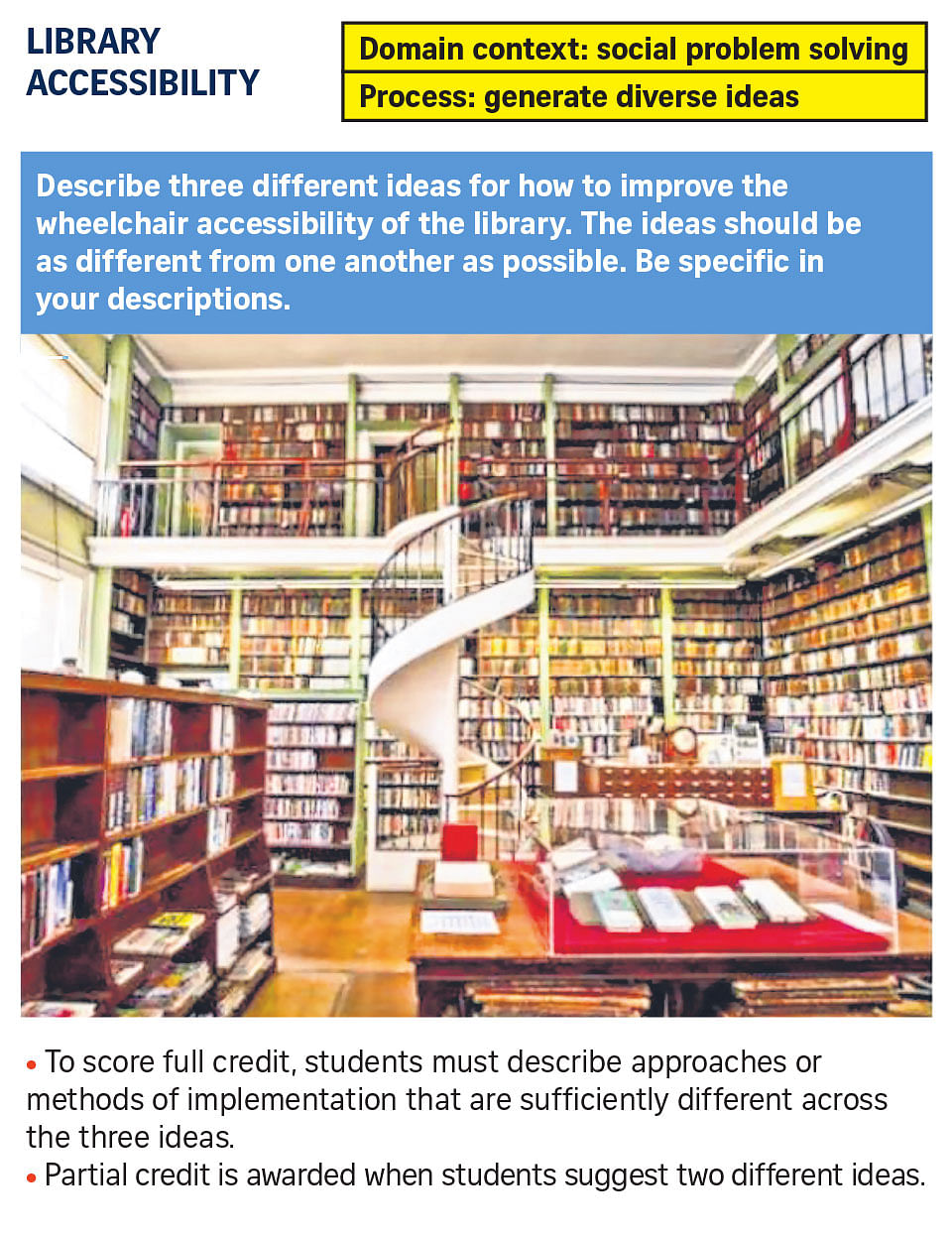
2. Write story ideas for robot film
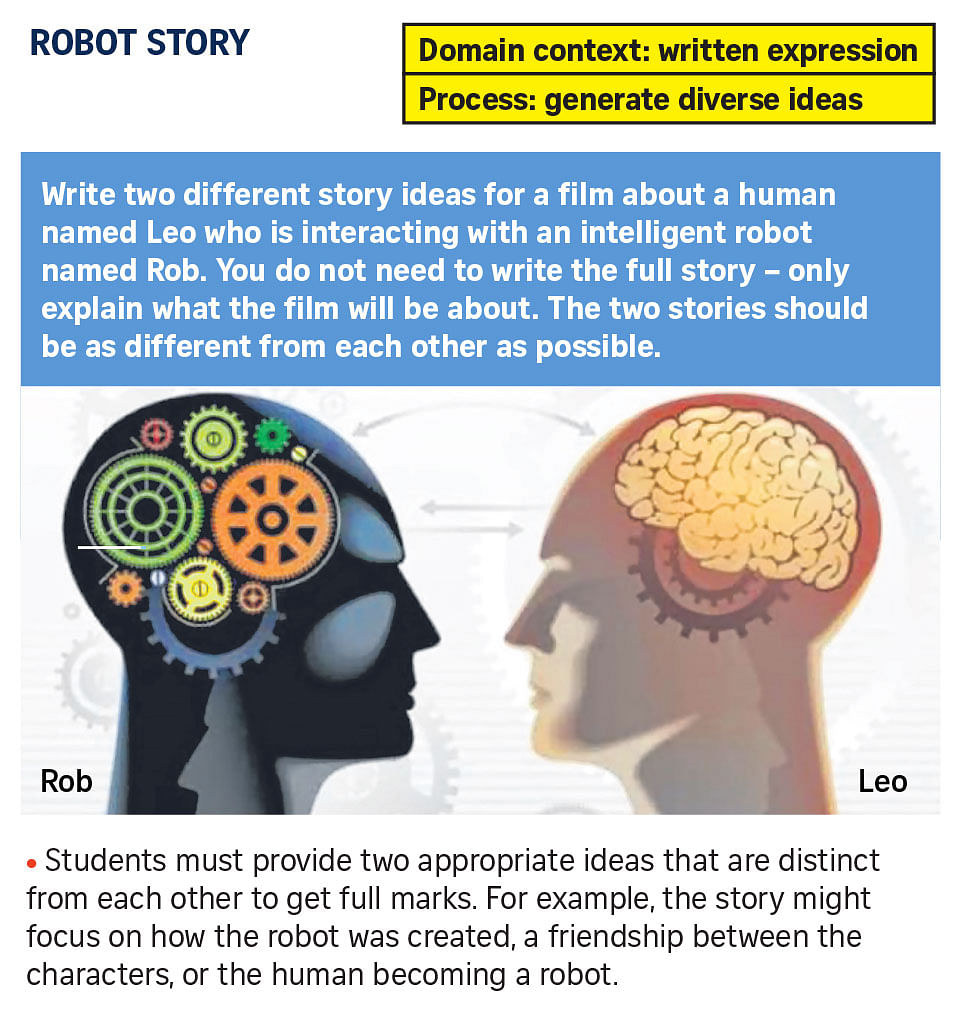
3. Write story idea for book with unusual cover
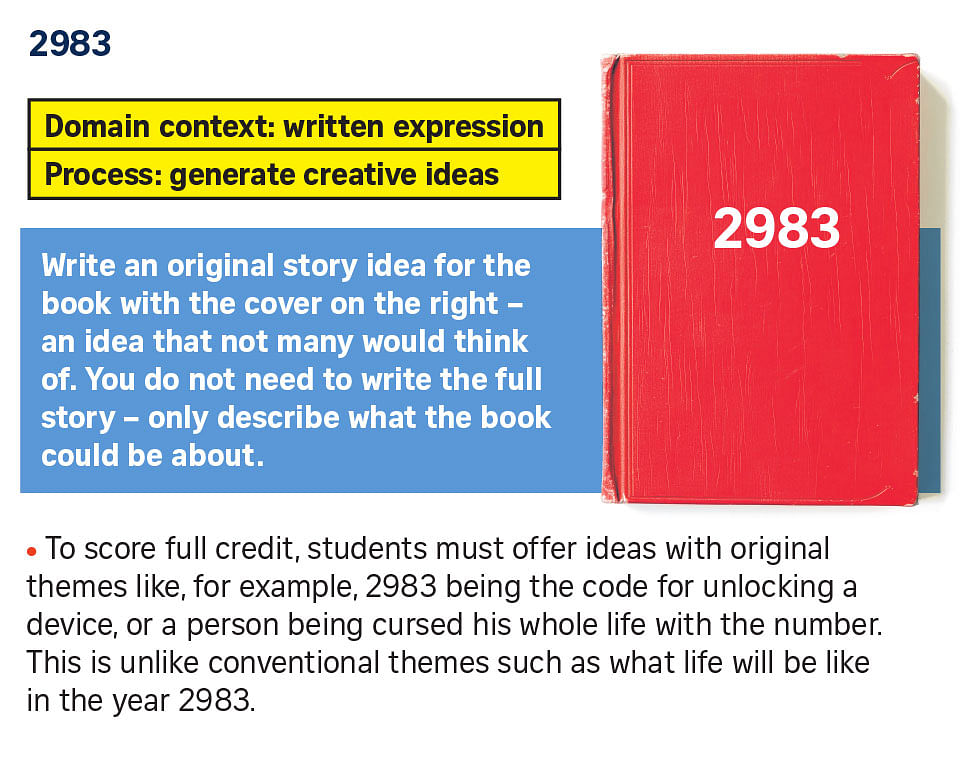
4. Create poster with scientific theme
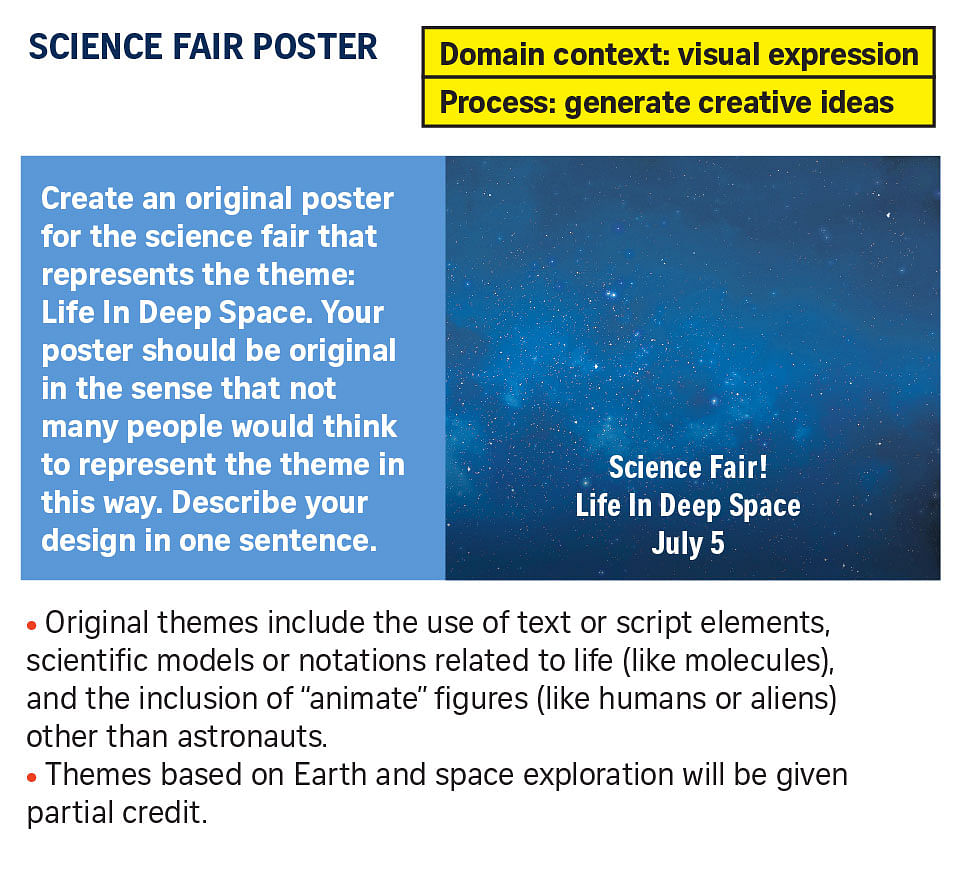
5. Improve experiment
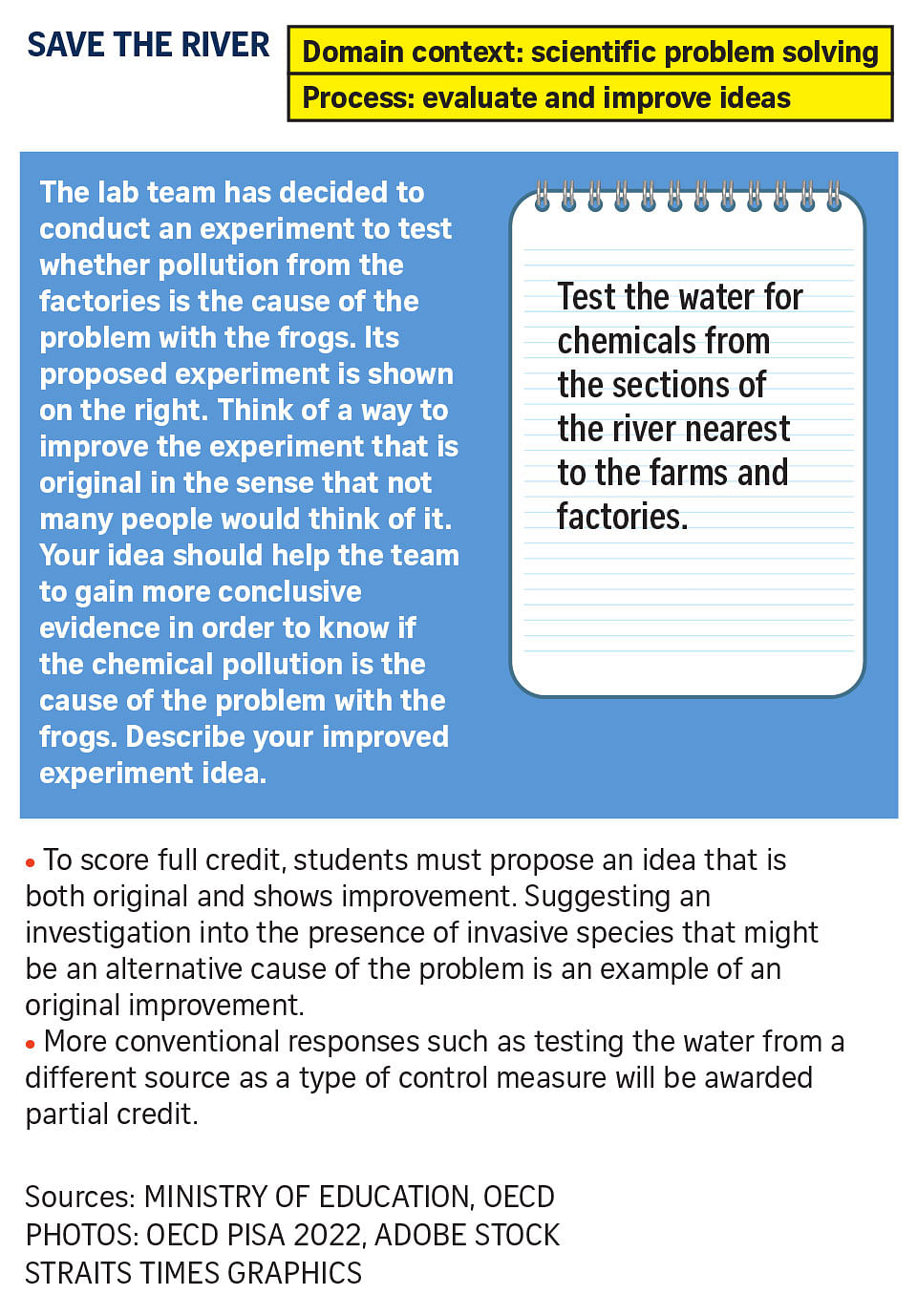
MORE ON THIS TOPIC
Less than half of S’pore st
UPDATED
JUN 18, 2024
SINGAPORE – Singapore’s 15-year-olds came out tops in a global test for creative thinking with a score of 41 points, beating students from 63 other education systems.
The Organisation for Economic Cooperation and Development (OECD) conducted the test as part of the Programme for International Student Assessment (Pisa) 2022.
It found that six in 10 of the Singapore students tested attained the two highest proficiency levels (five or six), demonstrating the ability to generate original and diverse ideas for a wide range of problem-solving tasks and contexts which required expression and imagination.
This was more than twice the OECD average proportion and the highest proportion among all 64 participating systems.
Some 6,600 15-year-old students across all 149 secondary schools and 15 private schools here, including international schools and madrasahs, participated in the study conducted from April to May in 2022.
Students from South Korea, Canada, Australia, New Zealand, Estonia and Finland took the next few top positions, scoring significantly above the OECD average of 33 points.
The test was part of Pisa 2022, which released its first report in December 2023 when it placed Singapore’s 15-year-olds as No. 1 in mathematics, science and reading.
OECD said it aimed to obtain insights into the students’ abilities through the test and questionnaire to generate, evaluate, and improve ideas, as well as their attitudes and perceptions of the school and social environments related to creative thinking.
In the one-hour test, students were given tasks that required them to generate creative ideas, as well as evaluate and improve on ideas. Full credit was awarded for uncommon ideas, while partial or no credit is awarded for common and conventional ideas.
In some scenarios in the test, students were asked to come up with ideas to improve the accessibility for wheelchair users in a library with a spiral staircase, improve an experiment for finding the cause of a problem with a frog population in a river, and suggest story ideas for a film about an intelligent robot and a human character.
OECD in its report said creative thinking measures a unique or different ability from the core domains it tests of reading, mathematics and science, because it focuses on generating new and original ideas, rather than the application of knowledge. In the creative thinking test, students tackle open problems, rather than producing the right or most optimal solution.
It said: “While creative thinking performance and academic performance complement each other, Pisa data show that it is possible for many students to be strong creative thinkers… academic excellence is not a prerequisite for excellence in creative thinking.”
The Ministry of Education (MOE) in its press release highlighted the fact that Singapore students from lower socio-economic status (SES) homes also did very well compared to their international peers.
They not only demonstrated higher levels of creative thinking than peers from bottom 25 per cent SES homes in OECD, but also outperformed the average OECD student who scored on average 33 points.
The MOE was also heartened by Singapore students reporting that their teachers valued students’ creativity and helped in nurturing their creative thinking. More than eight in 10 said that their teachers encouraged them to come up with original answers and they were given opportunities at school to express their ideas.
It noted though that while Singapore students held positive beliefs and attitudes towards creative thinking, more can be done to help them develop confidence in their ability to do creative work. Their lack of confidence showed in their responses to a questionnaire that followed the creative thinking test.
Singapore students rank top in maths, science and reading in OECD study
Pisa scores affirm Singapore’s approach to education but reveal areas for improvement
About three quarters of students here were of the view that creativity was not limited to the arts and almost half of the students reported a growth mindset about creativity, believing that creativity is malleable and can be improved.
But despite their high levels of creative thinking skills, Singapore students did not think of themselves as creative. Less than half of them here believed that they could produce good stories or drawings, or invent new things with a creative streak.
The MOE said schools and parents can help students develop greater confidence in their creative self-efficacy.
Reflecting on the findings, MOE’s director-general of education Liew Wei Li said: “We are very encouraged by our students’ performance, which also affirms the steadfast role our teachers have played in fostering creative thinking skills among students both in and outside the classroom. In a high-tech age where knowledge is easily available to all, Singapore students will need to continuously create new and meaningful value to the world. ”
Education Minister Chan Chun Sing in a Facebook post congratulated students here for doing well in the study and said: “We must continue to nurture and recognise creativity in our students intentionally – even beyond our schools.
“Employers and communities can play a part, by shaping a culture that instils confidence in our students and workers to build insight, work smarter and realise (not just imagine) new possibilities. I believe we will be able to achieve much more than just what these metrics tell us about our abilities.”
Dr Andreas Schleicher, OECD’s director for education and skills, and special advisor on education policy to the secretary-general, said: “As digitalisation and artificial intelligence advance, the premium on innovation, creativity and critical thinking increases compared to routine skills, which are more susceptible to automation.”
Since 2012, the OECD has included an optional innovative domain for each cycle in Pisa to measure selected 21st century competencies, such as collaborative problem solving (in 2015) and global competence (in 2018) where Singapore was also ranked first.
Are you more creative than a 15-year-old Singapore student?
To score higher, answers should be original – relatively uncommon within the pool of responses. Answers that are more common and conventional will get only partial or no credit. Here are some sample questions.
1. Generate ideas for wheelchair accessibility

2. Write story ideas for robot film

3. Write story idea for book with unusual cover

4. Create poster with scientific theme

5. Improve experiment

Less than half of S’pore st
No comments:
Post a Comment